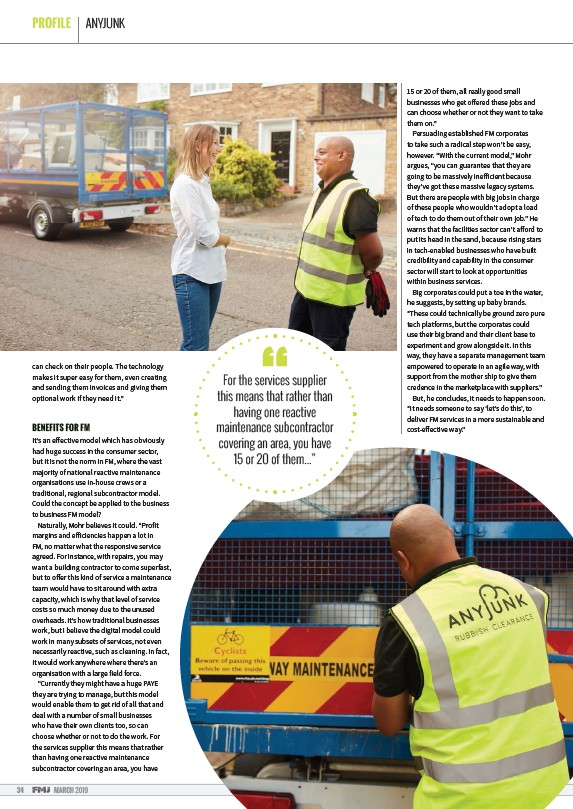
PROFILE ANYJUNK
can check on their people. The technology
makes it super easy for them, even creating
and sending them invoices and giving them
optional work if they need it.”
BENEFITS FOR FM
It’s an e‚ ective model which has obviously
had huge success in the consumer sector,
but it is not the norm in FM, where the vast
majority of national reactive maintenance
organisations use in-house crews or a
traditional, regional subcontractor model.
Could the concept be applied to the business
to business FM model?
Naturally, Mohr believes it could. “Profit
margins and e‚ iciencies happen a lot in
FM, no matter what the responsive service
agreed. For instance, with repairs, you may
want a building contractor to come superfast,
but to o‚ er this kind of service a maintenance
team would have to sit around with extra
capacity, which is why that level of service
costs so much money due to the unused
overheads. It’s how traditional businesses
work, but I believe the digital model could
work in many subsets of services, not even
necessarily reactive, such as cleaning. In fact,
it would work anywhere where there’s an
organisation with a large field force.
“Currently they might have a huge PAYE
they are trying to manage, but this model
would enable them to get rid of all that and
deal with a number of small businesses
who have their own clients too, so can
choose whether or not to do the work. For
the services supplier this means that rather
than having one reactive maintenance
subcontractor covering an area, you have
34 MARCH 2019
15 or 20 of them, all really good small
businesses who get o‚ ered these jobs and
can choose whether or not they want to take
them on.”
Persuading established FM corporates
to take such a radical step won’t be easy,
however. “With the current model,” Mohr
argues, “you can guarantee that they are
going to be massively ine‚ icient because
they’ve got these massive legacy systems.
But there are people with big jobs in charge
of these people who wouldn’t adopt a load
of tech to do them out of their own job.” He
warns that the facilities sector can’t a‚ ord to
put its head in the sand, because rising stars
in tech-enabled businesses who have built
credibility and capability in the consumer
sector will start to look at opportunities
within business services.
Big corporates could put a toe in the water,
he suggests, by setting up baby brands.
“These could technically be ground zero pure
tech platforms, but the corporates could
use their big brand and their client base to
experiment and grow alongside it. In this
way, they have a separate management team
empowered to operate in an agile way, with
support from the mother ship to give them
credence in the marketplace with suppliers.”
But, he concludes, it needs to happen soon.
“It needs someone to say ‘let’s do this’, to
deliver FM services in a more sustainable and
cost-e‚ ective way.”
For the services supplier
this means that rather than
having one reactive
maintenance subcontractor
covering an area, you have
15 or 20 of them...”